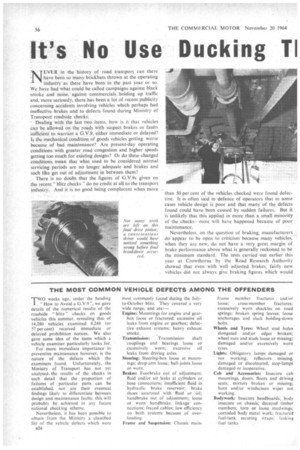THE MOST COMMON VEHICLE DEFECTS AMONG THE OFFENDERS T'WO weeks
Page 58

If you've noticed an error in this article please click here to report it so we can fix it.
ago, under the heading How to Avoid a G.V.9 ", we gave details of the numerical results of the
roadside " blitz checks on goods vehicles this summer, revealing that of 14.280 vehicles examined 8,248 (or 57 percent) received immediate or delayed prohibition notices. We also gave some idea of the items which a vehicle examiner particularly looks for.
For more immediate importance in preventive maintenance however, is the nature of the defects which the examiners found. Unfortunately, the Ministry of Transport has not yet analysed. the results of the checks in such detail that the proportion of failures of particular parts can be established, nor are their eventual findings likely to differentiate between design and maintenance faults; this will probably be achieved in any future national checking scheme.
Nevertheless, it has been possible to obtain from the Ministry a classified list of the vehicle defects which were
824 most commonly found during the Julyto-October blitz. They covered a very wide range, and are:—
Engine: Mountings for engine and gearbox Loose or fractured; excessive oil leaks from engine or gearbox; defective exhaust systems; heavy exhaust smoke.
Transmission: Transmission shaft couplings and bearings loose or excessively worn; excessive oil leaks from driving axles.
Steering: Steering-box loose at mountings; drop-arm loose; ball-joints loose or worn.
Brakes: Footbrake out of adjustment; fluid and/or air leaks at cylinders or hose connections; insufficient fluid in hydraulic brake reservoir; brake shoes saturated with fluid or oil; handbrake out of adjustment; loose or worn handbrake linkage connections; frayed cables; low efficiency on both systems because of overloading.
Frame and Suspension: Chassis main
frame member fractures and/or
loose: cross-member fractures; excessively worn shackles on road springs: broken spring leaves; loose anchorages and slack holding-down bolts.
Wheels and Tyres: Wheel stud holes elongated and/or edges broken; wheel nuts and studs loose or missing; damaged and/or excessively worn tyres.
Lights: Obligatory lamps damaged or not working: reflectors missing, damaged or discoloured; stop-lamps damaged or inoperative.
Cab and Accessories: Insecure cab mountings, doors, floors and driving seats; mirrors broken or missing; horn and/or windscreen wiper not working.
Bodywork: Insecure headboards; body insecure on chassis; decayed timber members; torn or loose mudwings; corroded body metal work; fractured fuel-tank securing straps: leaking fuel tanks.




















































































































